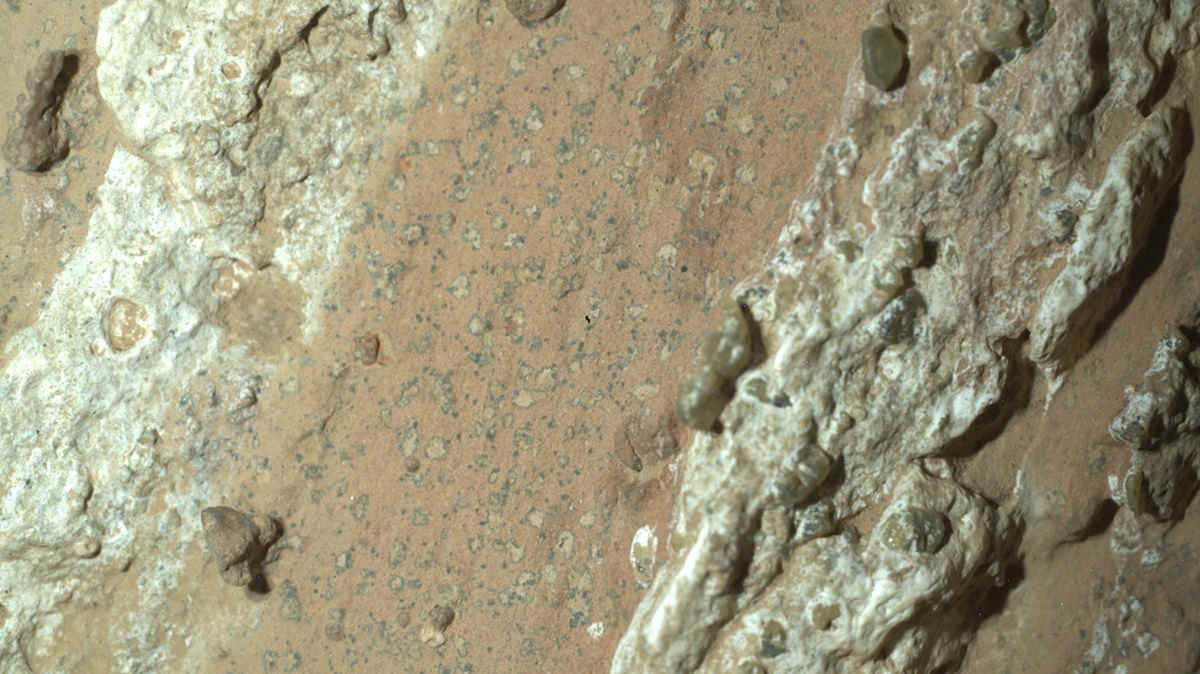The enigmatic question about possible life on Mars continues to baffle scientists, who earlier this month said the Red Planet was probably too cold for life to exist, but now they’ve found what they describe as “the first compelling detection of organic material,” on the plant.
Now a leopard-spotted rock on Mars might hold the key to the ongoing search for potential signs of ancient life on the Red Planet.
No, the leopard-print rock isn’t the impression of a spotty-skinned animal.
But it does possess a unique confluence of chemical signatures consistent with those that could have been left behind by living organisms billions of years ago.
The arrow-shaped rock is about 1m x 60cm and has been dubbed “Cheyava Falls” after a Grand Canyon waterfall. The NASA Mars rover, Perseverance, found the rock, which it adds to 21 others it has gathered for further analysis when can get them all back to Earth.
Perseverance took a core sample from the which was on the northern edge of an ancient river valley carved by water rushing into the Jezero Crater.
“This trip through the Neretva Vallis riverbed paid off as we found something we’ve never seen before, which will give our scientists so much to study,” says Nicola Fox, associate administrator at NASA’s Science Mission Directorate in Washington D.C.
Perseverance’s onboard chemistry lab, SHERLOC (Scanning Habitable Environments with Raman & Luminescence for Organics & Chemicals), indicated the presence of organic compounds in the rock.
As the name suggests, organic compounds are the carbon-based molecular building blocks of life. But they can also be produced by non-biological processes.
Running along the rock are large, white veins of calcium sulphate. This is smoking gun evidence of the presence of liquid water in the distant past.
Between the calcium sulphate veins are bands of red. A closer look at these regions shows dozens of irregularly shaped, light-coloured spots only millimetres in size. These splotches are ringed by black material containing iron and phosphate.
“These spots are a big surprise,” says astrobiologist David Flannery, a member of the Perseverance science team from the Queensland University of Technology in Australia. “On Earth, these types of features in rocks are often associated with the fossilized record of microbes living in the subsurface.”
The red bands are probably rich in hematite. The white spots might have formed in chemical reactions in the hematite which could have been an energy source for ancient microbes.
“We have our first compelling detection of organic material, distinctive colourful spots indicative of chemical reactions that microbial life could use as an energy source, and clear evidence that water – necessary for life – once passed through the rock,” says Fox.
“On the other hand, we have been unable to determine exactly how the rock formed and to what extent nearby rocks may have heated Cheyava Falls and contributed to these features.”
Millimetre-sized crystals in the veins made from olivine – a mineral formed in magma –have confounded the researchers.
It raises the possibility that the olivine and sulphate were introduced at temperatures too high for life to survive. They could also have behind the reactions which caused the leopard spots.
“Scientifically, Perseverance has nothing more to give,” says Ken Farley, Perseverance project scientist at Caltech.
“To fully understand what really happened in that Martian river valley at Jezero Crater billions of years ago, we’d want to bring the Cheyava Falls sample back to Earth, so it can be studied with the powerful instruments available in laboratories.”











/https://tf-cmsv2-smithsonianmag-media.s3.amazonaws.com/filer_public/34/31/3431771d-41e2-4f97-aed2-c5f1df5295da/gettyimages-1441066266_web.jpg)







Discussion about this post